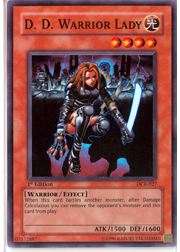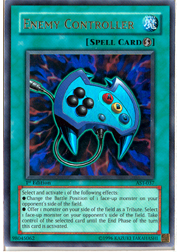Analyzing the Top 16 decklists from every Shonen Jump Championship is an interesting job. Some are completely net-decked from the most recent Shonen Jump and are expected, but not interesting. Some decks are completely new, like T-Hero Return, and are exciting to break down and think about. They could be the next big thing. But everyone is thinking that, and by the time my article comes out, most players have already rendered their own verdict.
 However, there are many decks that players skip over. Decks that, at first glance, appear to be copycats are often passed by without a thorough examination. With that said, players have often made small but significant choices that resulted in a Top 16 showing rather than falling short of it. Little things like playing Pulling the Rug in the main deck, making the proper side deck choices, or excluding popular cards that just weren’t good for the deck or metagame can make a huge difference. It’s fun to pick up on how tournaments often play out and which decisions keep on being successful.
However, there are many decks that players skip over. Decks that, at first glance, appear to be copycats are often passed by without a thorough examination. With that said, players have often made small but significant choices that resulted in a Top 16 showing rather than falling short of it. Little things like playing Pulling the Rug in the main deck, making the proper side deck choices, or excluding popular cards that just weren’t good for the deck or metagame can make a huge difference. It’s fun to pick up on how tournaments often play out and which decisions keep on being successful.
One trend that’s seen success for quite some time is playing against the main strategy while still using the best parts of that strategy for yourself. Cesar Gonzales showed us how a player could main-deck an anti-metagame strategy and side into the standard main deck with great success. His strategy has since been duplicated by many players . . . including Danny Brown, who played this build at Shonen Jump Championship Orlando:
Monsters: 19
2 Banisher of the Radiance
1 D. D. Scout Plane
3 Raiza the Storm Monarch
3 D.D. Survivor
1 Breaker the Magical Warrior
1 Snipe Hunter
3 Cyber Dragon
1 Spirit Reaper
1 Morphing Jar
1 D. D. Warrior Lady
1 Marshmallon
1 Zaborg the Thunder Monarch
Like Hugo Adame’s build from San Mateo, Brown’s is a weaker looking Cosmos deck. Cyber Dragon usually isn’t played in Cosmos builds, but Brown uses it here in order to make room for a transition strategy. The Dragon isn’t exactly dead either. Being a 2100 ATK special summon monster, Cyber Dragon adds a lot of raw power to the Cosmos build. Generally known for its lengthy game times (even against opponents with mostly dead hands), Cosmos decks usually don’t storm out wins on the first or second turn. Cyber Dragon makes that a possibility here, as an opponent crippled by Dimensional Fissure won’t be able to stand up to the swarm of monsters.
Raiza the Storm Monarch only makes things worse. If you think you’re in trouble with a dead hand against Cosmos decks, wait until a couple of copies of Raiza keep you from seeing any new cards. Aside from being generally good removal, Raiza has an equally important purpose in this deck as a means to delay the opponent from drawing his or her power cards. Cosmos decks can win quite easily when the opponent can’t find Heavy Storm, and Raiza the Storm Monarch is going to help make sure he or she doesn’t dig too deep in the deck to find it.
 is another offbeat choice, but one made, like Cyber Dragon, to allow for a transition. There’s a reason people don’t side from Cosmos into Perfect Circle Monarch: there aren’t enough cards in common to have both working decks. D.D. Warrior Lady can be used in both though, and as such was given a slot. The Warrior Lady was also an amazing metagame call. Cosmos decks were few and far between, and Destiny Hero - Disk Commander and Treeborn Frog were everywhere. Being able to take these key monsters out of play can devastate an opponent’s hand, turning a game-winning draw into nothing. With a pair of Reinforcement of the Army cards on hand, it’s always nice to be able to grab this remove-from-play mechanic at any given moment.
is another offbeat choice, but one made, like Cyber Dragon, to allow for a transition. There’s a reason people don’t side from Cosmos into Perfect Circle Monarch: there aren’t enough cards in common to have both working decks. D.D. Warrior Lady can be used in both though, and as such was given a slot. The Warrior Lady was also an amazing metagame call. Cosmos decks were few and far between, and Destiny Hero - Disk Commander and Treeborn Frog were everywhere. Being able to take these key monsters out of play can devastate an opponent’s hand, turning a game-winning draw into nothing. With a pair of Reinforcement of the Army cards on hand, it’s always nice to be able to grab this remove-from-play mechanic at any given moment.
Banisher of the Radiance does an even better job in the remove-from-play department. Taking anything that would be sent to the graveyard out of play means that Banisher prevents your opponents from dumping would-be live cards to the graveyard from anywhere. The amount of cards in an everyday deck that Banisher shuts down is ridiculous, and if played smartly, will cause no damage to the controller. Either a loss of options or 1600 damage per turn awaits an opponent who can’t take care of a Banisher, either of which is great news for this Cosmos build. Banisher can also be kept in during transition if necessary, which makes it even more valuable.
Spirit Reaper and Marshmallon serve the same purpose in both Perfect Circle and Cosmos strategies, and were two obvious choices for this deck. Morphing Jar was definitely a less obvious choice, but the possibility of doubling your available cards on a properly played Jar is just too much to pass up for most players. The Jar can also force your opponent to remove his or her hand from play if there’s a remove-from-play ability on the field. Doing so often rids your opponent of a hand that was being built up to beat you in one turn, or one that held some key monsters.
 was a great call for this deck as well. Its own uses with D.D. Survivor and in the mirror match are reason enough to play it, but its uses in the Perfect Circle transition are numerous too. Combining Treeborn Frog with Enemy Controller and a Monarch is a swell way to rid your opponent of his or her monster cards and deal 2400 damage in the process. Forcing defenders to attack mode can allow a team of Monarchs to pound a little guy for the win, and taking Light and Darkness Dragon on the chain can allow for some nasty tricks.
was a great call for this deck as well. Its own uses with D.D. Survivor and in the mirror match are reason enough to play it, but its uses in the Perfect Circle transition are numerous too. Combining Treeborn Frog with Enemy Controller and a Monarch is a swell way to rid your opponent of his or her monster cards and deal 2400 damage in the process. Forcing defenders to attack mode can allow a team of Monarchs to pound a little guy for the win, and taking Light and Darkness Dragon on the chain can allow for some nasty tricks.
Lightning Vortex and Brain Control are two other cards that are sometimes included in Cosmos builds. Since their playability is pretty good in Perfect Circle, Brown included them as well to slim down the number of cards he’d need to side. Against a standard Perfect Circle deck that will side into anti-Cosmos for game 2, I would guess that Brown would switch out all copies of D.D. Survivor, Dimensional Fissure, Macro Cosmos, Solemn Judgment, and Dark Bribe as well as the lone D.D. Scout Plane. Doing so would allow him to side into an aggressive PC deck that could take advantage of dazed opponents holding D.D. Survivor and Twister cards.
And Brown even has flexibility with his side deck choices. Solemn Judgment or Dark Bribe can stay in for matchups where their presence is welcome, or could replace Pulling the Rug and Banisher of the Radiance as the remaining game 2 tech cards. Solemn could be especially useful, putting a stop to the useful cards your opponent has drawn and leaving him or her with the dregs.
This deck is very good, and can play to an advantage against any opposing strategy. Transition decks seem to be gaining popularity among Shonen Jump Championship finalists. With Phantom Darkness legal for Jumps from here on out, only time will tell if Cosmos builds can win big.
—Matt Peddle